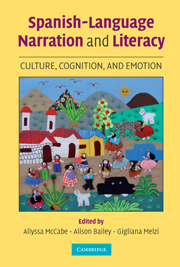Book contents
- Frontmatter
- Contents
- List of Contributors
- Preface
- Acknowledgments
- 1 Introduction
- PART ONE PARENT–CHILD NARRATIVES
- PART TWO DEVELOPING INDEPENDENT NARRATION
- PART THREE NARRATIVE LINKS TO LITERACY AND OTHER SCHOOL ACHIEVEMENTS
- 11 Latino Mothers and Their Preschool Children Talk About the Past: Implications for Language and Literacy
- 12 The Contribution of Spanish-Language Narration to the Assessment of Early Academic Performance of Latino Students
- 13 Cultural Variation in Narrative Competence and Its Implications for Children's Academic Success
- Author Index
- Subject Index
- References
13 - Cultural Variation in Narrative Competence and Its Implications for Children's Academic Success
Published online by Cambridge University Press: 05 June 2012
- Frontmatter
- Contents
- List of Contributors
- Preface
- Acknowledgments
- 1 Introduction
- PART ONE PARENT–CHILD NARRATIVES
- PART TWO DEVELOPING INDEPENDENT NARRATION
- PART THREE NARRATIVE LINKS TO LITERACY AND OTHER SCHOOL ACHIEVEMENTS
- 11 Latino Mothers and Their Preschool Children Talk About the Past: Implications for Language and Literacy
- 12 The Contribution of Spanish-Language Narration to the Assessment of Early Academic Performance of Latino Students
- 13 Cultural Variation in Narrative Competence and Its Implications for Children's Academic Success
- Author Index
- Subject Index
- References
Summary
Key Words: Cultural variation, narrative style, Latino children, academic discourse, academic success
ABSTRACT
This concluding chapter ties together and comments on themes from the preceding chapters, situating these themes in the broader context of current research on Latino children's experiences with academic discourse in schools. In the first half of the chapter, the findings presented in this book are situated within the important socioculturally based tradition of research on differences between the narrative styles of ethnic and linguistic minorities and those of middle-class, European American children, and the impact that such differences have had on the academic experiences of linguistic and cultural-minority children in U.S. schools. For example, qualitative investigations have shown that children from working-class, African American backgrounds tend to employ narratives that are associative in form rather than organized around a single topic. Narratives told in this topic-associating style tend to be negatively received by teachers, with the likely consequence that their tellers may grow to doubt their capacity for success at school-based language tasks. In the second half of the chapter, I discuss the ways in which the cognitive and linguistic skills implicated in narrative competence may provide a foundation for mastery of other modes of academic discourse and reasoning. I argue that in-depth studies of narrative competence and variations in narrative style such as those presented in this book are essential to deepening our understanding of children's preparedness for academic success.
- Type
- Chapter
- Information
- Spanish-Language Narration and LiteracyCulture, Cognition, and Emotion, pp. 332 - 350Publisher: Cambridge University PressPrint publication year: 2008



